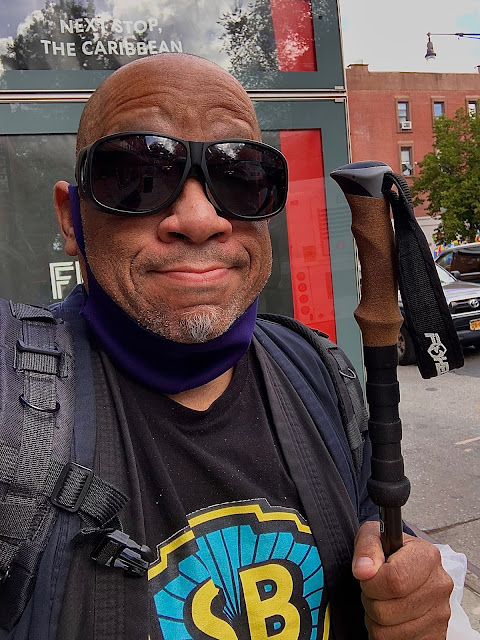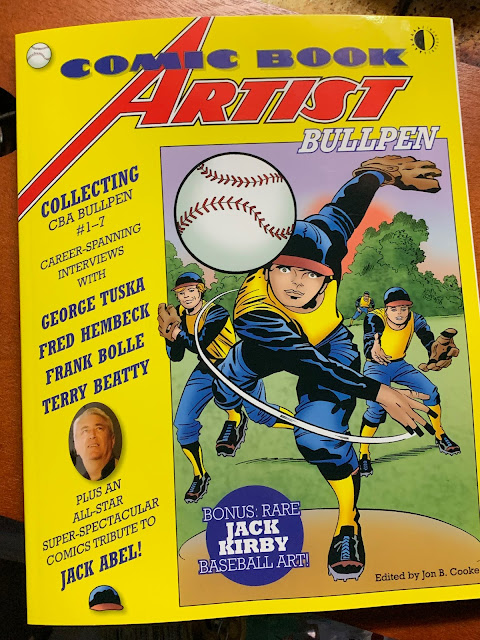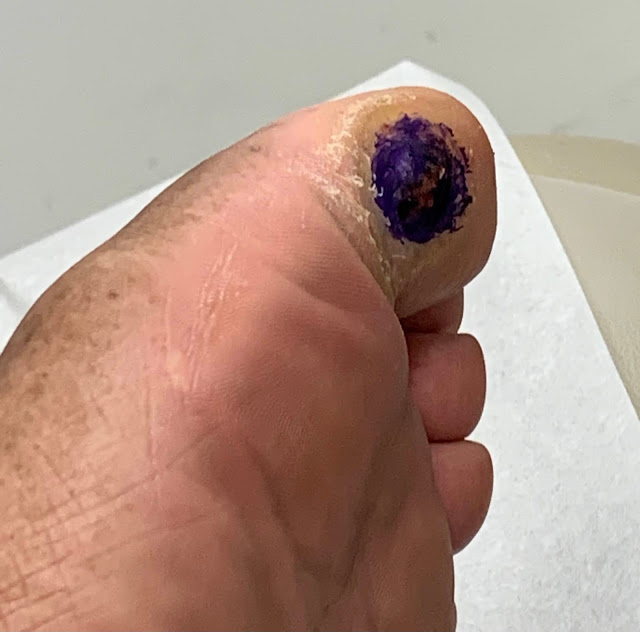NOTE: The text that follows was originally written nine years ago, though I have updated and expanded some of it to reflect the current edition. Also, the interior art seen here is from earlier editions — basically what I could cull from online — so the dialogue is not that of the current translation.
Picking up from where the previous book left off, Kenshiro's journey continues, as our hero battles the highly skilled soldiers of GOLAN (short for "God's Land"), a group of intense and murderous military elite who seek to establish themselves as the salvation of post-nuke humanity and come to Ken's attention when they kidnap random females from a village for use as unwilling breeding stock.
 A
GOLAN soldier murders a little girl's father right in front of her.
That kind of shit basically ensures a visit from Kenshiro...
A
GOLAN soldier murders a little girl's father right in front of her.
That kind of shit basically ensures a visit from Kenshiro...
Among
the hapless females is Rn, a girl of perhaps ten or eleven years old,
who has been one of Ken's annoying juvenile sidekicks since the series'
first installment (along with young teen thief Bat, both of whom are
the only constant fixtures in the series other than the hero), so
Kenshiro goes to the GOLAN stronghold to retrieve Rin and kick the
motherfucking shit out of the fascist survivalists, but not before
rendering scores GOLAN members bereft of life on the wasteland floor.
 One
of the rare instances of Ken utilizing weapons. This was early in his
career so he had not yet attained the "god of combat" level of badassery
that would come after a couple more story arcs, so I'll let it slide.
One
of the rare instances of Ken utilizing weapons. This was early in his
career so he had not yet attained the "god of combat" level of badassery
that would come after a couple more story arcs, so I'll let it slide.
But
while Ken is ready to single-handedly take on the hordes of skilled and
vicious commandos, what Ken doesn't expect is their sadistic one-eyed
leader, the Colonel, whose finely-honed martial prowess is paired with impressive
psychic abilities.
And up to this point we knew nothing of exactly how the world met its nuclear-assaulted fate, but that piece of info is kindly provided to Kenshiro (and us) when the Colonel relates how the drunken tycoons, military officials and heads of state set off WWIII as what amounts to a display of macho dick-waving.
When he and his elite Red Beret soldiers survived the holocaust thanks
to their training, the Colonel is convinced their survival was ordained
by God, and so GOLAN was born. When the bombs fell, mankind was so
fucked-up that even accurate accountings of the date were lost, so all
that's known is that the earth was devastated in the year "199X" (the
series started in 1983, so the '90's were still a ways off) and it was
up to GOLAN to take the reins of humanity (at least in the Colonel's
opinion). That's all well and good but the concrete reasons for the
pushing of "The Button" are afforded surprisingly short shrift, giving
us the Colonel's possibly warped point of view on the events leading up
to the rain of warheads. Whatever the case, if memory of the entire
series, even the untranslated parts, serves me, I don't think the
subject is ever broached again. Oh, well. Explaining WWIII's merely a
minor plot detail that would only get in the way of the opera of manly
histrionics and kung fu action, so why bother with it?
The
GOLAN arc is easily my favorite of the early period FIST OF THE NORTH
STAR — meaning the stuff before the introduction of Nanto Seiken
anti-hero Rei and Ken's older brothers — and is in every way a perfect
and exciting "lad's" comic. Filled with fast-paced, ultra-violent
martial arts action from start to finish, the gauntlet of badasses
Kenshiro has to face is in my opinion far more frightening than the
over-the-top and ludicrous forces in Shin's army. GOLAN's military angle
roots them more firmly in reality than just about any other villains in
the entire series, even with the Colonel's genuine superpowers taken
into account, and Ken's battles with the GOLAN forces are truly
spectacular. Besides, who wouldn't want to kick the living shit out of a pack of fascistic rapists who are even okay with violating children?
 Ken trash-talks the legion of GOLAN...
Ken trash-talks the legion of GOLAN...
Remember
the sequence in ENTER THE DRAGON where Bruce Lee battles his way
through Han's underground catacombs, taking on a legion of opponents
with his limbs and assorted weapons that happened to be lying around?
The GOLAN arc is FIST OF THE NORTH STAR's nod to that sequence and it
impresses thanks to Ken really getting to flex his early-era skills in a torrent
of blistering melee combat against seasoned professionals, rather than a
pack of what appear to be feather boa-wearing Christopher Street drag
queens on steroids. Plus, this sequence shows artist
Tetsuo Hara beginning to hit his stride as an illustrator of creative
mayhem, a talent that would grow exponentially with each arc. His work
even impresses when there's no fighting going on, allowing each of the
story's locations to fairly drip with atmosphere that places the reader
firmly within Kenshiro's violent world.
 Kenshiro
stalks the Colonel through the halls of the GOLAN citadel: an early and
impressive example of artist Tetsuo Hara's flowering cartooning skills. I would love to own the original artwork for this...
Kenshiro
stalks the Colonel through the halls of the GOLAN citadel: an early and
impressive example of artist Tetsuo Hara's flowering cartooning skills. I would love to own the original artwork for this...
Following
the total destruction of GOLAN, the next arc kicks off with the
obnoxious villain Jackal, an uninspired baddie who quickly wears out his
welcome and wastes narrative time, as his is nothing more than a rote wasteland scoundrel.
Basically, after pissing off Ken one time too many, Jackal pulls out his last resort: the long-imprisoned "Devil Reborn," a psychotic literal giant who is the last master of Rakan Nioken, the fist of the Arhat Deva kings, a 5,000-year-old Indian assassination art banned by the emperor for its vicious savagery.
The Devil Reborn (as seen in the colorized Gutsoon edition).
Devil Reborn is a straight-up giant monster and an undeniably impressive adversary, but he's too extreme for Kenshiro to be facing this early on in the proceedings. After this fight (and victory), the major opponents that Ken faces can at first come off as punt by way of comparison. That said, it's a mercifully short arc.
But this volume close with the start of the arc that cements the group of core protagonists by introducing two major plarers: Mamiya, the series' sole female warrior who fights alongside Kenshiro, and who bears a startling resemblance to Ken's lost love, Yuria...
And Rei, a bishonen ("beautiful male") master of Nanto Suichoken, the elegant "swan style" of Nanto Seiken, the yang to Hokuto Shinken's yin.
Rei: a drifter of unforeseen significance.Mamiya is the protector of a small village (apparently the one that Ken wandered into in the first chapter, as the local holy man appears to be the same guy), and she enlists Ken as more muscle, not knowing that he's pretty much a demi-god of martial arts. When Rei arrives out of the wastes, he too is conscripted as protection against the roving gangs of marauders who would prey upon the weak. However, Lin and Bat instantly distrust the stranger, because his "are not the eyes of one who would help others." She is not wrong, as Rei has been single-mindedly killing his way across the barren landscape while searching for "the man with seven scars" with murder on his mind. When he and Ken meet, Ken's scars are covered by his sirt and leathers, and once Rei's obsession with finding his scarred target is made known, Ken, Lin, and Bat keep quiet on the subject. By why is Rei hunting the man with seven scars? That is a question that must remain unanswered until the next volume...
Had the conclusion of the Shin storyline and the
beginning of the Jackal arc been excised, the GOLAN arc would have made
for a great stand alone adventure, and if it would work great if packaged as a stand-alone volume. As previously noted, the introduction of Rei signals the beginning of the series' classic era, but even so, it still takes a little longer for the fuse to truly ignite. At this point the creative team was still hashing out the elements, and they are only now beginning to coalesce. Rei's introductory story serves to demonstrate the differences between the Hokuto and Nanto styles, which we begin to see in the next book.



































